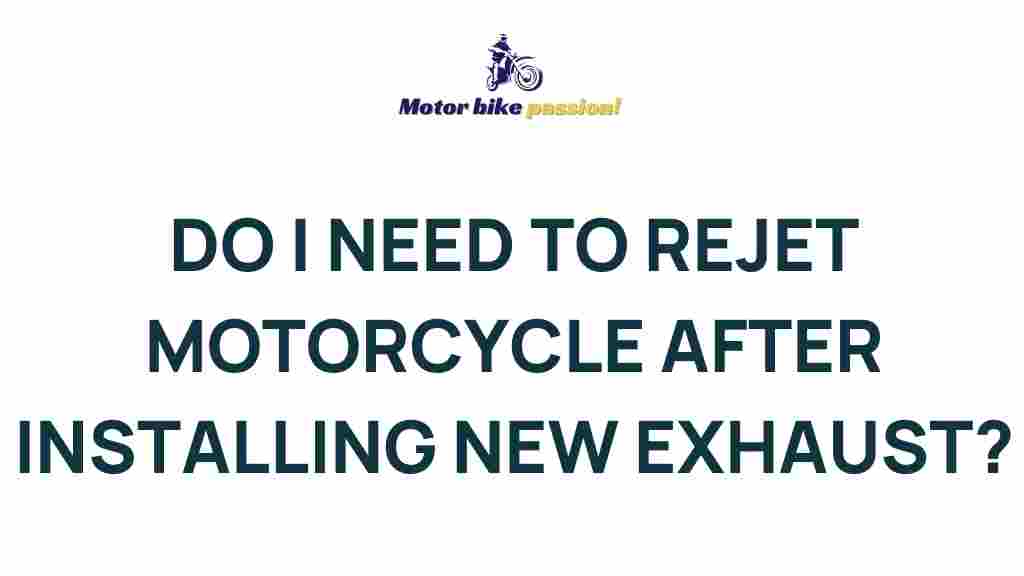Unleashing the Power: The Importance of Rejetting Your Motorcycle After Upgrading the Exhaust
Upgrading your motorcycle’s exhaust system is one of the most popular modifications among enthusiasts looking to enhance their bike’s performance. However, many riders overlook a crucial step in the tuning process: rejetting. This article will explore the importance of rejetting your motorcycle after upgrading the exhaust, detailing how it can significantly affect your bike’s power, efficiency, and overall performance.
Why Rejetting is Essential After an Exhaust Upgrade
When you install a new exhaust system, there are several changes that occur in how your motorcycle’s engine operates. These changes can impact the air-fuel mixture, which is critical for optimal engine performance. Here’s why rejetting is essential:
- Improved Airflow: After upgrading your exhaust, the bike usually experiences improved airflow. This means that more air is entering the engine, which can lead to a lean air-fuel mixture if the fuel delivery is not adjusted.
- Power Gains: Proper rejetting allows your motorcycle to take full advantage of the new exhaust system, unlocking potential power gains you might otherwise miss.
- Efficiency: A well-tuned engine runs more efficiently, saving on fuel costs and reducing emissions.
- Preventing Engine Damage: Running too lean (too much air relative to fuel) can cause engine damage. Rejetting ensures a balanced air-fuel mixture.
Understanding the Basics of Rejetting
Rejetting involves changing the size of the carburetor jets or adjusting the fuel injection settings to alter the air-fuel mixture. Here are the basic components involved:
- Main Jet: This controls the fuel flow at high RPMs. A larger main jet may be necessary for optimal performance after an exhaust upgrade.
- Needle Position: Adjusting the needle position can help fine-tune the mixture during mid-range RPMs.
- Pilot Jet: This affects the mixture at low RPMs and is crucial for smooth idling and throttle response.
Step-by-Step Guide to Rejetting Your Motorcycle
Rejetting your motorcycle may seem daunting, but with the right tools and guidance, it can be a straightforward process. Follow these steps for a successful rejetting:
Step 1: Gather the Necessary Tools
Before you start, ensure you have the following tools:
- Basic motorcycle tools (screwdrivers, wrenches, etc.)
- Jet kit specific to your motorcycle model
- Carburetor cleaner
- Small containers for parts
- Safety goggles and gloves
Step 2: Remove the Carburetor or Access the Fuel Injection System
Depending on whether your motorcycle uses a carburetor or a fuel injection system, the removal process will vary:
- Carburetor: Disconnect the fuel lines and throttle cables, and remove the carburetor from the engine.
- Fuel Injection: Refer to the manufacturer’s guide for accessing and adjusting fuel settings.
Step 3: Clean the Carburetor
Before making adjustments, clean the carburetor thoroughly with carburetor cleaner to remove any debris or deposits that could interfere with performance.
Step 4: Install New Jets
Following the instructions provided in your jet kit, replace the main jet, pilot jet, and adjust the needle position as necessary. Choose jets that are appropriate for your exhaust upgrade.
Step 5: Reassemble and Test
Reassemble the carburetor or fuel injection system and reconnect it to your motorcycle. It’s essential to double-check all connections before starting the bike.
Step 6: Tune the Engine
Start your motorcycle and allow it to warm up. Adjust the idle speed and mixture screws according to the specifications in your service manual. Test ride your motorcycle to feel the changes in performance.
Troubleshooting Common Issues After Rejetting
After rejetting, you may encounter a few issues. Here are some common problems and their solutions:
Problem 1: Rough Idling
If your motorcycle is idling roughly after rejetting, it may indicate that the pilot jet is too small or the mixture is too lean. Adjust the pilot jet or mixture screw to enrich the fuel mixture.
Problem 2: Hesitation on Acceleration
This can be caused by a lean condition at mid-range RPMs. Check the needle position and consider raising it to allow more fuel into the mixture.
Problem 3: Excessive Smoke
Black smoke from the exhaust typically indicates a rich mixture. Consider installing smaller jets or adjusting the mixture screw to decrease fuel flow.
Conclusion: Unlocking Your Motorcycle’s Full Potential
Rejetting your motorcycle after upgrading the exhaust is a crucial step that can unlock significant power and efficiency gains. By ensuring the air-fuel mixture is balanced, you not only enhance your bike’s performance but also contribute to its longevity and reliability. Don’t overlook this important tuning process; your motorcycle deserves the best to perform at its peak.
For more information on motorcycle tuning and performance upgrades, check out our detailed guide. Additionally, for expert advice, you can visit Motorcycle Performance.
Remember, a well-tuned motorcycle not only rides better but also provides a more exhilarating experience on every ride. Happy riding!
This article is in the category Maintenance Tips and created by MotorBikePassion Team
